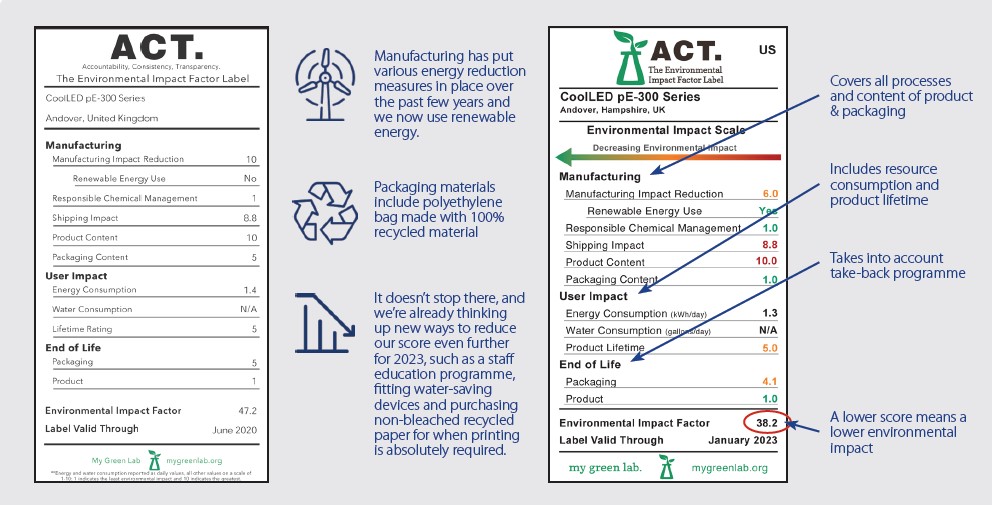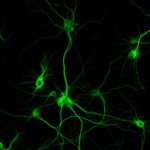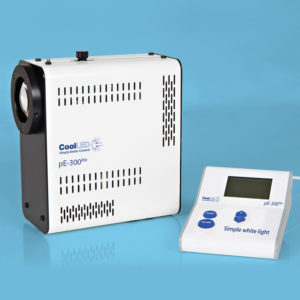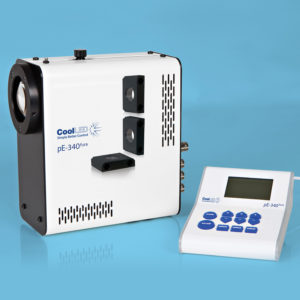Lab Sustainability
Laboratories are notoriously resource-intensive, but there is a trend across academia, industry and government to reduce their environmental impact. Suppliers of laboratory equipment are also working alongside not-for-profit organisations such as My Green Lab to drive change, and a successful example is the phasing out of toxic mercury-based lamps for fluorescence microscopy. Every scientist can help make a positive change, and sometimes it is important to reconsider traditional technologies and ways of working, and ask whether there is a more sustainable alternative.
Find out:
- Why improving laboratory sustainability is important and may soon impact some grant awards
- How LED illumination offers a sustainable alternative to lamps for fluorescence microscopy
- How to make sustainable purchase decisions with the My Green Lab ACT Label
It is now more important than ever to go the extra mile and adopt a more sustainable approach in how we live, as well as how we work. Anyone who has worked in a lab knows how they are resource-intensive in terms of energy, water and plastic. Compared to offices, a typical lab uses up to five times as much energy and water, in addition to vast amounts of single-use plastics and other waste.1 But it doesn’t have to be this way, and the scientific community is driving change across academia, industry and government.
The UK Research and Innovation (UKRI) Environmental Sustainability Strategy details a plan to consider environmental sustainability as part of funding decisions, grant and training terms.2 Many universities and companies across the pharmaceutical and biotechnology sectors now also have sustainability officers to reduce environmental impact, which extends to their laboratory facilities. A trend is therefore emerging of organisations supporting their laboratory staff to make sustainable decisions, which may soon help them secure grants.
Organisations such as My Green Lab and Green Light Laboratories are also working hard to support scientists, procurement officers and sustainability directors in making sustainable decisions. Another factor is the availability of environmentally friendly technology, and this is where suppliers of laboratory equipment have a role to play.
One such piece of laboratory equipment belongs to the fluorescence microscope, which is a familiar sight in many life science laboratories. The fluorescence microscopy light source has traditionally relied on energy-hungry and toxic mercury-based lamps, but LED technology is now available as a cleaner, more efficient and high-performance alternative. In this white paper, we explain specifically why laboratories are moving away from mercury-based lamps. We also highlight this trend in the wider context of the growing support available to help scientists make informed decisions for a sustainable future.
LED Illumination Systems are the Sustainable Choice
Compared to traditional mercury-based illumination such as metal halide lamps, the reduced environmental impact of LED Illumination Systems is largely down to two factors: saving energy and avoiding mercury. An independent comparison of a CoolLED Illumination System and traditional mercury lamp found that the mercury lamp consumed more than 10 times more energy over 25,000 hours of use compared to a CoolLED pE-300ultra.3
These numbers might seem surprising, but this takes into account the warm-up time required before use of traditional lamps and a cool down period before they can be safely used again. LED illuminators for microscopes instead switch on or off instantly, and need only draw power when illumination is required. Many laboratories leave their mercury-based illuminators switched on all day to ensure availability when required, yet LED microscope lighting can be powered up in no time at all. This improved energy efficiency also comes with a potential cost saving of £30,000. Although many laboratories do not pay directly for energy consumption, the wider organisation can benefit financially. For this reason, it is worth contacting your Facilities department and enquiring about financial support for energy-efficient equipment, which are sometimes known as ‘Green Grants’.
Traditional lamps also contain mercury, which is notoriously toxic and gradually accumulates in tissue as it passes through the food chain, damaging wildlife populations. Due to its harm to people and the environment, the use and disposal of mercury is subject to legislation in many countries. Cost savings are also a factor here, since disposing of old mercury lamps has a financial impact over time. It is also worth considering that countries are moving towards banning mercury lamps. The Minamata convention, which is an agreement to address widespread mercury pollution, has now been adopted by 131 countries, and there is increasing pressure from the United Nations to ban mercury-based lamps, since a viable alternative now exists in the form of LEDs.4 For laboratories with several microscopes, planning ahead with a phased introduction of LED illumination is recommended in advance of a future ban.
Sustainability at CoolLED
Since our team of four introduced the first commercially available LED Illumination System in 2006, we have led the way in offering scientists a sustainable alternative to toxic mercury-based lamps for fluorescence microscopy.
We’ve come a long way from the early days where the irradiance* of LEDs was catching up with traditional lamps. Now our powerful, safe and sustainable LED Illumination Systems have won the race and we won’t rest until mercury lamps are phased out from every laboratory.
This commitment to sustainability runs through the entire organisation and we take our responsibility seriously, constantly striving to reduce our environmental impact. We use 100% renewable energy, have a robust recycling scheme and LED lighting (with PIR lighting in less frequented areas). USBs accompanying our products now have cardboard housing and recycled plastic bag packaging.
* Irradiance: the radiant power at a surface per unit area, measured in mW/mm2. This is our preferred term as measured at the sample plane and eliminates any confusion between power, intensity and radiant intensity.
Making Sustainable Decisions
While sustainable laboratory equipment is available, it can be challenging to make the best purchasing decision. To help scientists understand the environmental impact of equipment and make sustainable purchasing choices, My Green Lab developed The ACT Label. ACT stands for Accountability, Consistency and Transparency, and is like an “eco-nutrition label” for lab products. Each label provides a score which reflects the complete environmental impact of manufacturing, using, and disposing of a product and its packaging.
To help bring sustainability to fluorescence microscopy, the CoolLED pE-300 Series has been registered for the ACT Label since 2018. By having a score, this helps suppliers focus on ways to reduce their impact even further and become increasingly sustainable. For example, at CoolLED we recently reduced our pE-300 Series score from 47.2 to 38.2, and the key improvements we made are explained in Figure 1. You can view the full certification on the ACT Label Database. Initiatives such as the ACT Label therefore reach further than a single product and establish an actionable approach to empower suppliers and end users alike to ‘walk the walk’ of sustainability.

Conclusion
LED Illumination Systems offer a sustainable technology for fluorescence microscopy illumination. They also enhance fluorescence microscopy through advanced control which improves contrast, reduces photodamage and enables high-speed imaging. For these reasons, many scientists would like to make sustainable choices but may not have the resources to upgrade to modern equipment when their existing
setup is working adequately; but there are options to consider:
• Contact your Facility or Estates department as more institutions are offering ‘Green Grants’ to fund energy efficient equipment.
• If you are purchasing a new microscope, ask your supplier about the light source and whether they can supply an LED illumination system instead of a metal halide.
• When making a purchase decision, even for consumables, check the ACT Label Database for a certified alternative, or ask your supplier about their sustainability initiatives.
• Become a My Green Lab ambassador – there are many simple adjustments you might be able to achieve without extra cost.
In this white paper we have explored the replacement of mercury lamps with a sustainable alternative, but there are many areas where you can take a moment to ask the question – “is there a better way?”

References
1. Watch, D & Tolat, D., (2016). Sustainable Laboratory Design. Whole Building Design Guide. Available at: www.wbdg.org/resources/sustainable-laboratory-design (accessed 20 May 2021)
2. UK Research and Innovation (2020). UKRI Environmental Sustainability Strategy. Available at: https://www.ukri.org/wp-content/uploads/2020/10/UKRI-050920-SustainabilityStrategy.pdf (downloaded 28 April 2021)
3. Green Light Laboratories (2017). mercury versus LED study. Available at: www.coolled.com/wp-content/uploads/2019/08/Green-Light-Laboratories-Mercury-versus-LED.pdf (downloaded 28 April 2021)
4. United Nations Environmental Programme (2017). Minamata Convention on Mercury. Available at: http://www.mercuryconvention.org/Portals/11/documents/Booklets/COP1%20version/Minamata-Conventionbooklet-eng-full.pdf (downloaded 28 April 2021)




